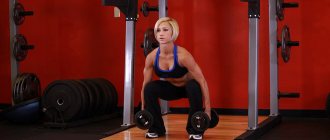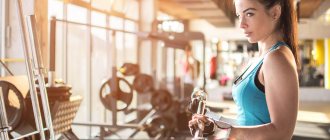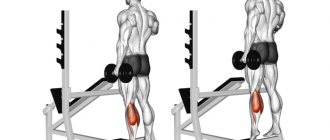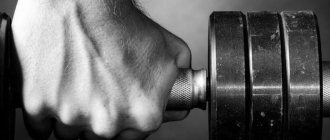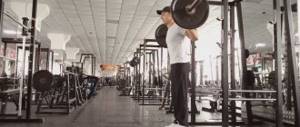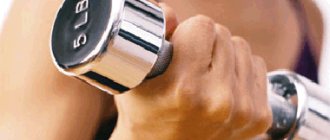What muscles work
Standing dumbbell rows to the chin work several muscle groups at once. It is possible to shift the emphasis of the load in one direction or another depending on the width of the grip and the height of the elbows. More on this later.
So, the main working muscles are:
- Deltoid. The middle and anterior bundles receive the greatest load.
- Trapeze. The trapezius is noticeably engaged when your elbows rise above the horizontal position. Additionally, the degree of participation of the trapezius in the movement is influenced by the width of the grip. With a narrower grip, the load on these muscles is more noticeable. However, this remark is more relevant for barbell rows to the chin than for dumbbells.
Additionally, stretching engages the core stabilizer muscles and biceps.
Exercise technique
Pulling dumbbells to chin level is done as follows:
- Take dumbbells, stand straight and place your feet shoulder-width apart. Place your arms in front of you, wrists turned toward your body, elbows slightly bent. The back in the starting position is straight, the gaze is directed forward, there is a natural deflection in the lower back.
- Bend your arms with dumbbells, pointing your elbows up. The distance between the dumbbells does not change. The dumbbells move along the body, the body position is straight, the elbows do not move forward. Bring the dumbbells to chin level and your elbows to their highest possible height. Until parallel with the floor is reached, mainly the deltoid muscles work, after which the trapezius is activated. At the top, concentrate on maximizing muscle tension.
- Lower the dumbbells along your body to the starting position.
As for the number of repetitions and approaches in this exercise, the recommendations are as follows: to gain shoulder mass and increase muscle volume - 8-12 repetitions in 3-4 approaches.
If you are an experienced athlete and lift heavy weights, perform 4-6 repetitions. This technique not only gives growth, but also develops muscle strength.
When performing the exercise, try to avoid jerking and throwing the weight upward. This is not advisable, since others will work instead of the target muscles. In addition, any sudden movements when working with weights create unnecessary stress on the joint-ligamentous system.
Dumbbell row to the chin
The dumbbell chin row places less demands on the structure of the shoulder joint and can be performed by both beginners and professionals. It is often included in women's and adolescent training. The exercise is more flexible in terms of shifting load vectors, and allows you to pull dumbbells not only directly upward, but also along an arcuate path. Due to these changes, the athlete can either use the trapezius or not. Many athletes prefer to adjust their technique and shift the load to the upper back.
Execution technique
Initial position
- Stand up straight, gather your shoulder blades and, by bending at the hip joint, remove the dumbbells from the racks;
- Take a vertical position, lean forward slightly by bending at the hip, if you plan to shift the emphasis to the upper back;
- Lower your arms vertically so that it is possible to pull the dumbbells up without unnecessary movements
Movement
- As you exhale, a thrust is performed. This is a movement in the elbow joint, due to which the dumbbells go up so that the athlete works mainly with the middle bundle of the deltoid muscle. You need to find the position of the dumbbells in which there is no pain and discomfort in the shoulder joint yourself. The exercise does not have the best reputation because it is not only traumatic, but requires a thoughtful approach;
- The row is a smooth upward movement of the dumbbells; it is not recommended to perform it jerkily or pull the weights upward. At the point of peak stress, you need to hold the projectiles at the top;
- Perform the required number of repetitions and place the dumbbells on the racks
Attention
- Raising your shoulders and shrugging movements shifts the load to the trapezius muscles, so lifting is best avoided;
- It is not at all necessary to bring the shoulder to the ear in order to engage the deltoids; it is worth working in a medium amplitude, and avoiding impact in the shoulder joint. It can lead to pinched nerves and serious pain;
- The wrists should remain in a neutral position. Their excessive bending can lead to pain in the joint;
- If you lean back during a deadlift, you should choose the weight of the dumbbells and their optimal size, so that it is easy to lift. Constantly bending backwards can lead to overload of the lower back and pain;
- The dumbbells should not be close to each other and collide, then the mechanics of the movement will remain more natural;
- The abs should be tense, the buttocks should be included in the work, the back should be tense, this will avoid the swing of the body during the exercise.
Recommendations
- This movement does not serve to develop speed. It is best to perform the deadlift with a controlled, slow style that does not cause a major change in body position;
- You should not choose working weights that require cheating;
- It is best to avoid overload and not perform the exercise by pushing the dumbbells with your feet, momentum, or trapezius jerk;
- Only correct technique can protect against subacromial impingement syndrome. You should not raise your hands aggressively, as high as possible, or literally pull the concept to your chin. Many people call this row a chin row, and that's what they assume when doing the exercise. This approach is categorically incorrect; the trajectory should not contribute to the occurrence of pain;
- There is no need to try to press your hands with dumbbells to your body if there is pain in the joint in this position. When an athlete experiences discomfort, his joint is overloaded, but he still wants to perform this exercise, it is worth sticking to the trajectory as in an explosion, that is, moving the projectiles slightly forward and away from the body
Execution Variations
- Single dumbbell row . You can pull one dumbbell by the discs with both hands, or one dumbbell alternately. The first option can only be considered by people with narrow shoulders, flexible wrists and suitable strength. Usually these are teenagers and short girls. The second option is preferable for bodybuilding, as it allows you to achieve symmetrical development of the muscles of both halves of the body;
- Rows with dumbbells can also be carried out with different arm widths , which allows you to create a load on both the biceps, triceps and shoulders, and practically isolate the shoulder, turning it off from work.
Analysis of the exercise
What muscles work
- The main working muscle group is the deltoid array. The front, middle and rear deltoids should be loaded in this exercise, you need to understand that the front and middle deltoids work to a greater extent in this exercise than the rear ones;
- The auxiliary muscles are the same as in the barbell chin row. Round muscles of the back, trapezius, latissimus, rhomboids. The muscles of the core and legs work as stabilizers.
Pros of exercise
- The main advantage is mobility and ease of selection of scales. Movement with dumbbells can be done by everyone, from almost zero level. You still need to grow to the weight of the bar;
- Dumbbells are easy to buy for home so you can train with them and get everything you need at home. An average student will progress through a set of dumbbells of different weights for about six months;
- The movement with dumbbells is biomechanically healthier, it can be considered more natural, since the bar does not rigidly fix the trajectory;
- In the dumbbell variation, it’s easy to do drop sets and supersets; many people’s shoulders respond well only to multi-plane work and require both the inclusion of upward presses and involvement in the row protocol;
- There are dumbbells in any gym, you don’t need to select and choose different options, so you can train according to the plan anywhere;
- The movement easily fits into the format of any workout in a busy gym, since almost any gym has several rows of dumbbells, and this makes the equipment convenient and accessible;
- In extreme cases, dumbbells can be replaced with disks from a light barbell;
Preparation for execution
The exercise should be performed after a good warm-up. It rarely comes first in the training plan; rather, it may be second or third. But in any case, shoulder training requires serious preparation.
You must actively rotate your shoulders back and forth to warm up your rotator cuff and prevent injury. This can be achieved solely with the help of regular joint exercises, but you can also perform exercises such as the Cuban get-up or the scarecrow.
Warm-up movements for the rotator cuff can also be done with rubber. Then they take the form of abducting the forearm along an arcuate trajectory while standing. This simple movement allows you to get rid of pain in the shoulder joint and warm up quickly and efficiently.
If the deadlift is performed by a person with an already active shoulder injury, he should first do a warm-up with a band, which will allow the parts of the joint to be mechanically removed from each other. You need to tie a rubber shock absorber to a vertical support and perform rotations with your hand in a small amplitude.
There can be one or even several warm-up approaches if a person is trying to perform the movement with optimal heavy weight.
Proper execution
- The correct thing to do is not to rock the body. A slight tilt at the very beginning of the exercise and amplitude is allowed, and the movement is performed in one plane due to the strength of the arm muscles. If swinging is still necessary, it is worth thinking about the quality of the movement itself and technique;
- You should carefully place the weight in your palm. Small distortions are allowed, but a complete shift of the weight to one part of the amplitude should not interfere with the exercise;
- You should not grab the handles “housewise”, that is, shift most of the weight down;
- The exercise is performed at a normal pace, calmly, thoughtfully, without jerking or pushing the weight upward;
- It is not recommended to pull dumbbells towards your ears, as shown in some aerobics videos. This exercise should not become a way to get out of the natural range of motion;
- Feet stand firmly on the floor, no rolling from heel to toe and back;
- Contracting the biceps, which shifts the load to this muscle group, is an unacceptable technique. The biceps are involved a little in the movement, but you should not turn the shoulder raise into elbow bending;
- To eliminate the trapezius from the movement, you need to unlearn raising your shoulders. If you can’t get rid of unnecessary movements, you should give up large weights and learn to do the work with small ones;
- The easiest way to track the technique is with the elbows; they should move in the same trajectory and along the body, and not in different directions;
- Overexertion of the hands should be avoided. For many, the dumbbells slide down due to the use of gloves, and therefore the hands take an anatomically unnatural position; the person bends the hands and overloads the forearms. The easiest way to overcome this is to get rid of the gloves;
- Sometimes wrist straps are used in this exercise to make lifting easier, and this is justified, since the purpose of the movement is not to pump up the forearm, and there may be a lot of pulls in the plan that require constant inclusion of this area
Errors
- Violation of the trajectory of the projectile;
- Rocking the body, helping with the legs;
- Brushes crease;
- Hand push-off
Efficiency Tips
If less weights are used than working ones, it is worth training in a shortened amplitude, removing excess load due to the adequate position of the hands;
For those who cannot turn off the trapezius, it is recommended to start with minimal weights;
Standing against a wall works well; if a person is used to cheating, he should lean his back against the wall so that it does not interfere with raising his elbows
Inclusion in the program
This exercise is included in the program as a main or finishing exercise. It all depends on the capabilities of the athlete and his physical development. Most people do the exercise in 10-12 repetitions in 3-4 sets.
Although the movement is multi-joint, due to its nature it is not suitable for setting strength records.
Contraindications
You should not create additional stress on your shoulders if there is any injury to the joint, a tear in the cuff or a tear.
Errors in technology
In order for the exercise to give maximum effect and not cause harm to joints and ligaments, pay attention to the common mistakes that occur when performing it. This will help you control your movements and work on muscle development without the risk of injury:
- Do not point your elbows forward when lifting dumbbells. This is a traumatic position for the shoulder joints. The elbows move through the sides in a vertical plane.
- Keep your body straight throughout the entire movement, do not bend your neck or arch your back. Any deviations in body position from the correct one remove the load from the target muscles.
- Don't use too much weight, which will force you to break your technique. This will not give the desired effect, you will only waste your time.
Pulling with dumbbells is more gentle on the joints than the same exercise with a barbell. By performing it in combination with other exercises, you can get a beautiful outline of the muscles of the shoulder girdle, increase their volume and develop strength.
Standing dumbbell row to the chin, high row
The standing dumbbell row to the chin exercise is also called a high row. The high row powerfully develops the lateral deltoids and upper trapezius muscles. The mechanics of the exercise allow you to use quite a significant weight on dumbbells, as well as various intensive training techniques (see below about cheating).
Initial position
Take dumbbells in your hands and stand up straight. Feet shoulder width apart. Turn your palms towards your hips. The arms are slightly bent at the elbows.
Technique for dumbbell rows to the chin (high row)
At the same time, pull the dumbbells up to chin level, bending your elbows. The dumbbells should move as close to your body as possible and almost strictly vertically. Throughout the movement, try to keep your elbows higher than your hands. Essentially, you should be doing lateral and upward elbow raises, using the strength of your trapezius and deltoids, with your forearms just hanging down.
Having raised the dumbbells to the desired level, hold them in this position for a moment, and then smoothly lower them, performing the opposite movement. Immediately pull them up again, don't hold them down for a second. Complete the required number of repetitions.
Dumbbell row to the chin. Initial position.
Dumbbell row to the chin. Finish.
Dumbbell row to the chin. Initial position.
Dumbbell row to the chin. Finish.
Please note: try to choose a weight of dumbbells so that you do not have to help yourself by swinging your body. The torso should remain motionless. In addition, do not rush to use heavy weights of dumbbells, since high rows with dumbbells require the development of technique and precision of movements.
If you are experienced, you can use significant weight using the cheating technique. Then the dumbbell row to the chin will turn into a snatch row.
The exercise trains not only the trapezius muscles, but also the lateral deltoids, anterior deltoids, biceps, and forearm muscles.
The back extensors receive static load.
Breath
Exhale when lifting dumbbells, inhale when lowering.



